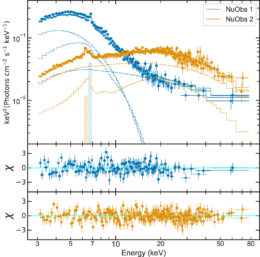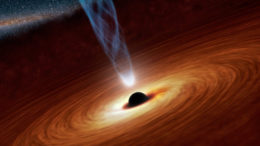A new X-ray source in a Milky Way star cluster has puzzled astronomers. What’s the most likely explanation for this source’s unusual properties?
Things That Go Bump in the Night Sky

NuSTAR X-ray spectra of MAXI J1848-015 during the outburst (blue) and as the outburst was fading (gold). Model fits are shown as dashed lines. [Pike et al. 2022]
The observations revealed that the source suddenly flared into view before beginning to fade just five days later. What kind of astrophysical object was responsible for this brief outburst? A team led by Sean Pike (California Institute of Technology) has performed an in-depth analysis of the object’s X-ray spectra to find out.
An X-ray Exploration
Pike and collaborators found that during the outburst, the source’s emission was dominated by soft, low-energy X-rays, peaking around 5 kiloelectronvolts. A week later, as the outburst was fading, harder, higher-energy X-rays surged, and though the source was fainter overall, its emission peaked between 20 and 30 kiloelectronvolts. This transition from soft and bright emission to hard and faint emission is typical for X-ray binaries — systems containing a compact object like a neutron star or black hole that is accreting material from a stellar companion.

This artist’s impression shows an outflowing jet of energetic particles and a bright corona, which appears just above an accreting black hole. [NASA/JPL-Caltech]
Neutron Star or Black Hole?

The Spitzer Space Telescope discovered GLIMPSE-C01, the star cluster where MAXI J1848-015 resides, in 2004. [NASA/JPL-Caltech/H. Kobulnicky (Univ. of Wyoming)]
- Spin: The source spins almost as fast as is physically possible for an object of its size and angular momentum — far faster than even the most quick-whirling neutron stars.
- Luminosity: Archival X-ray observations of the star cluster where the source is located show that when the object is in a quiescent state, its luminosity is roughly 1,000 times fainter than a typical neutron star.
- Outburst length: The outburst is short compared to those from most — but not all — other accreting black holes.
Based on these findings, the authors rule that MAXI J1848-015 is most likely an accreting black hole, though some pieces of the puzzle aren’t a perfect fit. One lingering mystery is how an accreting black hole with a close-in accretion disk can have such a low luminosity. Catching another outburst in the act should help illuminate the nature of this intriguing source!
Citation
“MAXI and NuSTAR Observations of the Faint X-Ray Transient MAXI J1848-015 in the GLIMPSE-C01 Cluster,” Sean N. Pike et al 2022 ApJ 927 190. doi:10.3847/1538-4357/ac5258
